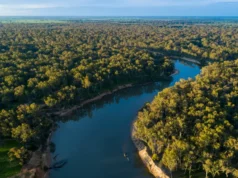
Under the midday sun, the township of Lake Tekapo must be the brightest place on the planet. The light that reflects off the snow-blanketed hills onto the town’s namesake lake is so sharp you have to avert your gaze. The irony is that Lake Tekapo is a town that demands to be kept in the dark.
They call it “Mackenzie Country,” a vast intermontane basin in the barren centre of New Zealand’s South Island where the world is mostly taken up by sky. Famous for its sheep farming, today the region is riding on the back of stars as well as sheep, finding an unlikely niche as a world-renowned astro-tourism destination.
4300 square kilometres of the basin and adjacent Aoraki/Mount Cook National Park has been declared the Aoraki Mackenzie Dark Sky Reserve, in recognition of its (usually) clear skies, and community commitment to limiting light pollution. It’s the largest dark sky reserve in the Southern Hemisphere, and the centrepiece is Dark Sky Project, an $11 million educational hub with access to New Zealand’s premier astronomical research observatory – home of the country’s largest telescope – atop nearby Mt John. It celebrates its tenth anniversary this year.
Darkness is not a prerequisite for stargazing. I arrive for an afternoon, indoor multi-media immersion, called Dark Sky Experience, which sometimes confuses more than it illuminates. Our guide Tu shows us to a room dotted with bean bags, and sets the tone by introducing us to the apparently comparable disciplines of “Western astronomy” and “Māori astronomy,” (leaving aside the fact that “Western astronomy,” commonly known simply as “astronomy” likely originated around Mesopotamia in the Middle East).
We’re shown a cinematic video on a huge, wrap-around screen, explaining the Big Bang and the fusion of hydrogen atoms to create stars. Thus life begins. Tu then recounts the stirring story of Rehua, the eldest Māori god and Chief of the Stars, who lives in the highest heavens and is represented by Antares, the red supergiant in the constellation of Scorpio. Rehua is visited by his younger brother Tāne Mahuta – God of the Forest – who travels to the heavens in a waka (Māori canoe). Rehua bestows Tāne with gifts to take back to Earth, including the essence of knowledge and all living creatures. Thus life begins.
“Even though this one star has two different stories,” Tu says, “and come from two completely different cultures, doesn’t mean one is right and one is wrong. They’re both right, just in their own way.”
Also – quite evidently – one is mythology and one is science. It’s hard to understand what’s gained by blurring the lines between the two, and from where I sit it has the (presumably) unintended effect of devaluing both. Mythology needn’t feel threatened by science, unless conflated with it; and the dogged toil by scientists to unwrap the mysteries of the universe is surely rendered impotent if remodelled as just another cultural belief, no more or less true than wakas in the sky.
It’s a shame, because the Māori myths are beautiful on their own; I grew up in New Zealand and know them well. For a wonderful read seek out Witi Ihimaera’s 2020 book Navigating the Stars: Māori Creation Myths, which imbues the myths with contemporary relevance without needing to seek equivalence with science.
The second room is alight with glowing models of stars. We can touch and even hear them. Tu gives a succinct summary of the complex discipline of asteroseismology – the study of oscillation in stars – culminating in an aural rendering of how stars “sing” depending on their stage of life. Spoiler alert: in four billion years our sun will become a red giant and eat the Earth. You’ve been warned.
In the final room the floor comes alive with projections of constellations Māori used to help them hunt and gather, such as the great eel, the weka (a native bird), and the Polynesian rat (kiore). Tu makes the important point that constellations shouldn’t be viewed as representations of animals, but measurements of time – a calendar to inform when to carry out certain activities. That mātauranga Māori (traditional knowledge) is in danger of slipping away, due to colonisation, modernity, and the encroachment of artificial light. “Some people who come here never seen stars,” says Tu, as dozens of constellations light up the darkened room. “At least not like this.”
Twilight allows time for a stroll around the quiet township (the Chinese coach tourists Lake Tekapo caters for are still conspicuously absent) and to check into the comfortable digs of Peppers Bluewater Resort. I walk back for dinner at the Dark Sky Diner, surely the finest restaurant to ever share floorspace with a gift shop, and gaze out the window across the breeze-raked, turquoise lake. Argentinian restaurant manager Fabian Seligmann deftly steers an understaffed ship, delivering a cargo of classic South American dishes (unexpected, but a delight) including a 500g tomahawk steak grilled to perfection, paired with Hawkes Bay merlot. Darkness is met with a caramel and walnut-filled crêpe (panqueque) that takes me to the stars.
I’m booked for a stargazing session at the University of Canterbury Mt John Observatory, but a cool change has smothered the sky with cloud. Instead, our group is offered an alternative indoor experience: a virtual tour of the universe via a computer simulator and open-source planetarium. Our Malaysian guide Huili’s passion is infectious as she pilots us on a mind-bending cruise through the cosmos, whizzing through the Milky Way at warp speed and visiting the celestial maternity wards of nebulas, where 400 million new stars are born each day, our own fleeting existence rendered laughably insignificant. Before filing out into the winter night Huili leaves us to ponder that humbling, universal truism: “We are all made from stars.”
Something we can all agree on.
Read the story here


